Circuit-Zone.com - Electronic Projects
Posted on Saturday, July 30, 2011 • Category: AVR
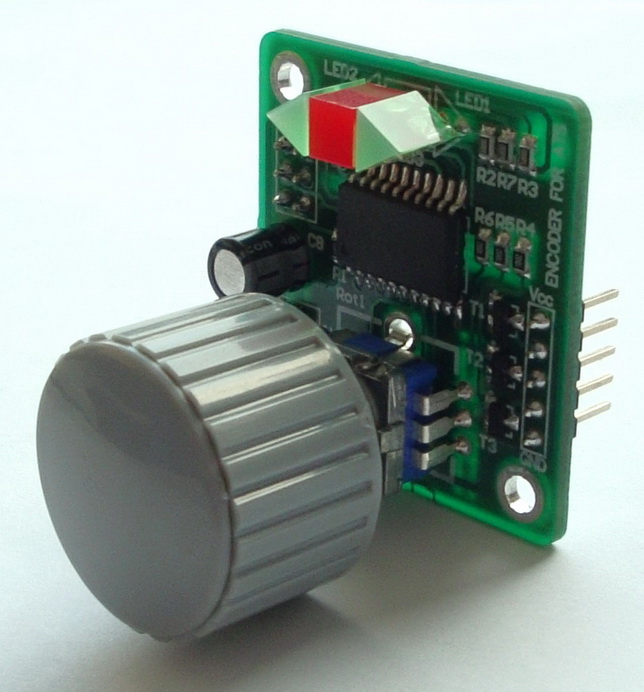
This equipment is dedicated for an easier control of the popular mini-transceiver AT Sprint known by ham radio operators as ATS (series ATS-2, ATS-3, A, B, B.1 compatible). Originally the ATS has just four push buttons on the top cover and in combination with the paddle it is possible to send all commands to ATS including the tuning, scanning etc. After connecting the rotary encoder accessory module an easy tune, scan and other functions are available as same as on the big size desktop transceivers. Comfort and operation is much higher even with this mini transceiver.
Posted on Monday, July 18, 2011 • Category: AVR
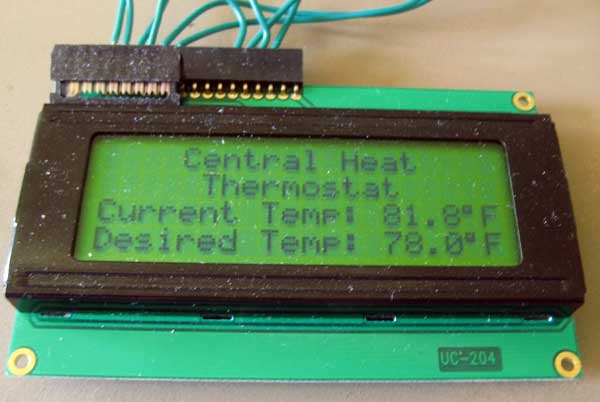 I wanted to share my project of modifying the temperature sensor project and turning it into a thermostat with ATmega168. I added a digital output to drive an LED to "warm" the temperature sensor when the current (actual) temperature falls below the desired temperature.
Two push buttons come in as digital inputs one to ramp the desired temperature up and the other to ramp it down.
The logic is simple bang-bang control to turn the LED on and off based on the relationship of actual temperature to desired temperature. It simulates a thermostat in heater mode. The LED is off when the current temperature is above the desired temperature and turns on once the current temperature falls below.
Posted on Saturday, July 16, 2011 • Category: AVR
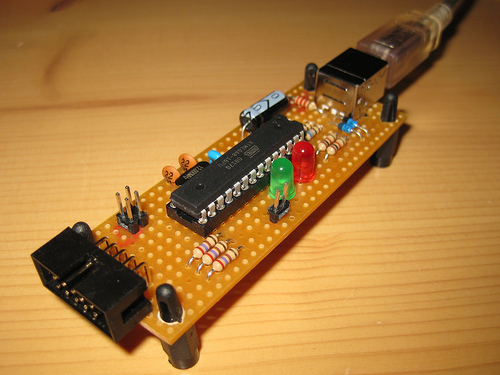 USB AVR Programmer for Atmel AVR microcontrollers. USB AVR Programmer is made of an Atmega8 and few components. The programmer uses a firmware driver that makes this programmer attractive to many amateurs.
Another thin why this programmer is so popular is because it is officially included and supported in WinAVR.
Once again lets see what this programmer is made off and how to set it up.
The core of USB AVR Programmer adapter is Atmega8 microcontroller clocked by 12MHz crystal. Soldered board is ready to be connected via simple USB cable with B type connector (Computer side needs A type of connector). Resistors R2 and R6 are current limiting resistors, that protect computer USB port. Resistor R7 helps computer to recognize device as LS (Low Speed). Diodes D1 and D2 indicates about data transfer. Header SV1 is compatible with STK200/300 just 4 and 6 pins are used for RXD and TXD (may be used for other purposes).
Posted on Saturday, July 9, 2011 • Category: AVR
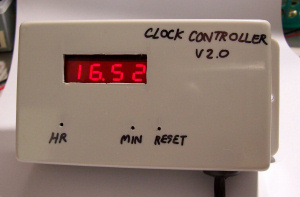 Build a digital clock that turns AC load on/off through relay with preset time. The clock is based around 7-segment LED display with multiplex connection and AT89C2051 microcontroller. It is nice to be used as the display for clock controller. So I spent my weekend built the board. Below are the pictures for outlook and internal. The board is quite small. The output has small relay for 0.5A AC load. The program clock.c was written in ‘C’ language and was complied by Micro-C Compiler from DunfiledDevelopment Systems. The memory model is TINY. The hex file of clock.c suitable for downloading by Easy-Downloaderis clock.hex.
Posted on Tuesday, July 5, 2011 • Category: AVR
 Here's AVR programmer for programming AVR microcontrollers such as the AT90S1200 via the parallel port. AVR programmer is extremely simple. IC1 provides buffering for the signals that travel from the parallel port to the microcontroller and vice versa. This is essentially everything that can be said about the circuit. The two box headers (K2 and K3) have the ‘standard’ ISP (in system programming) pinout for the AVR controllers. The manufacturer recommends these two pinouts in an attempt to create a kind of standard for the in-circuit programming of AVR microcontrollers. These connections can be found on many development boards for these controllers. The software of AVR programmer carries out the actual programming task.
Posted on Wednesday, June 1, 2011 • Category: AVR
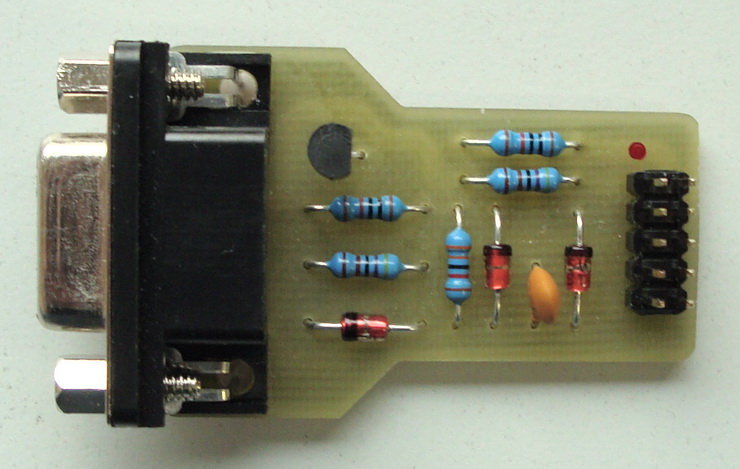 This is simple to build AVR programmer for Atmel microcontrollers from AVR family. The microcontrollers must support serial programming. AVR programmer is connected to a PC through the RS232 serial interface and can be used with the PonyProg or Avrdude software programmer. AVR programmer is quite simple and it is based on the SI-Prog from the author of PonyProg software.
AVR programmer can be used for programming Attiny13, Attiny26, Attiny2313, Atmega48, Atmega88, Atmega168, Atmega16, Atmega8 and it works very well. I also use the programmer with desktop computer, laptop, with and wihout USB-to-RS232 adapter and it works in all cases.
Posted on Tuesday, May 10, 2011 • Category: AVR
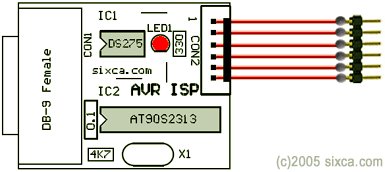 This AVR ISP original by ATMEL you can found on "AVR software
and technical Library - April 2003" CD-rom. It small component count I design new PCB and change some component that easy to build small PCB. The new firmware was writen by John Samperi for AT90S2313. This code can program more devices.
Posted on Monday, May 9, 2011 • Category: AVR
 This is a very simple and easy to build programmer for Atmel microcontrollers from AVR family. The microcontrollers must support serial programming. This programmer is connected to a PC through the RS232 serial interface and can be used with the PonyProg or Avrdude software programmer. The programmer is quite simple and it is based on the SI-Prog from the author of PonyProg software. The Zener diodes D2, D3 with the resistors R2, R3 reduce the voltage from the ouput pins DTR, RTS on the serial port to around 5V which is suitable for microcontroller (MOSI, SCK). MISO signal is connected directly to the input CTS pin. The Zener diode D1 with the resistor R1 drive the NPN transistor T1, which controls RESET signal. The AVR microcontrollers are in reset when the signal has low level. The resistor R5 works as a pull-up for reset signal. The resistor R4 helps to close the transistor T1. The programmer has standard 10 pins header.
Posted on Thursday, April 21, 2011 • Category: AVR
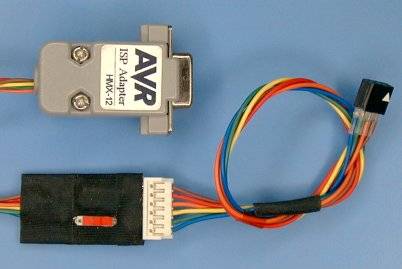 This is an AVR ISP Programmer which is controlled via COM port. Signal levels of the RS-232C line is converted to the target level, so that target device can operate in entire range of the VCC. And also it can be used as an communication cable to communicate between host PC and target program (this is explained in the following section). This ISP adapter is sufficient to develop most of the AVR applications.
Posted on Friday, December 3, 2010 • Category: AVR
 It was four years ago which I needed an Oscilloscope to be able to see the received codes from PT2272. (This is a Remote Control Decoder chip).
Later on I made so many other things with this device which I will explain it later . ( such as the measurement of the low value voltages and even the supplies with high values and so on...).
Although on that time I was in hurry so didn't design a PCB and I mount it on a pure, bread board. Its a good portable one, as the Battery is put on it, so you can have it in your pocket.
Posted on Thursday, May 6, 2010 • Category: AVR
 This project is based on obdev's RemoteSensor example and their firmware-only USB implementation; the main change is the replacement of the analog sensors with a Sensirion SHT11 digital temperature and humidity sensor.
Posted on Friday, April 30, 2010 • Category: AVR
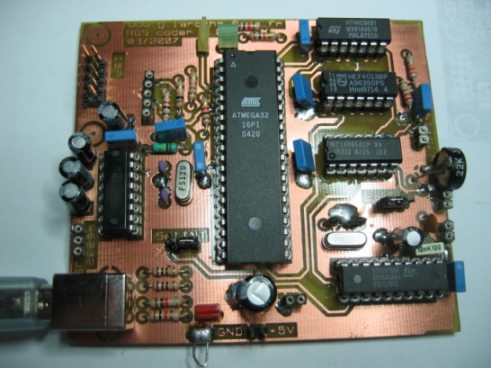 This board is a RDS coder using an ATMEL AVR ATmega32.
This board can be controled by a RS232 link, USB interface or SPI.
TA data is displayed wiyth a LED and can be controled by :
- Hardware input
- RS232
- USB
- SPI (not yet implemented)
Posted on Tuesday, April 27, 2010 • Category: AVR
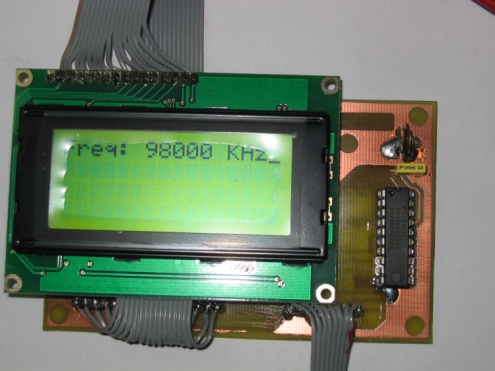 This is the transmitter PLL module with ATMega8, MC145170 and 16x4 LCD Display.
Posted on Tuesday, April 20, 2010 • Category: AVR
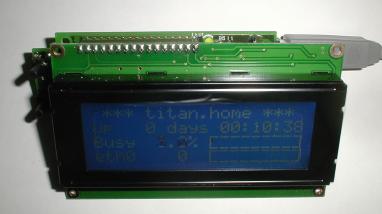 LCD2USB is a open source/open hardware project. The goal of LCD2USB is to connect HD44780 based text LCD displays to various PCs via USB. LCD2USB was meant to be cheap and to be made of easily available parts. It is therefore based on the Atmel AVR Mega8 CPU and does not require any difficult to obtain parts like separate USB controllers and the like.
Posted on Tuesday, April 20, 2010 • Category: AVR
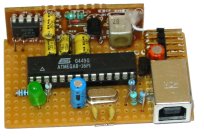 RemoteSensor is a wireless thermo- and hygrometer with an USB port on the receiver. You can draw fancy diagrams of temperature and humidity for up to 16 wireless sensors.
Posted on Monday, April 19, 2010 • Category: AVR
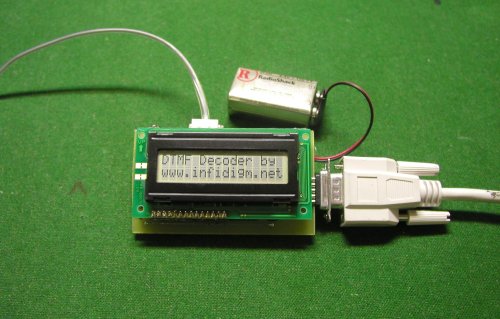 The DTMF decoder 2 is a useful tool used for decoding DTMF (Dual Tone Multi frequency) generated by telephones. The decoded digits are viewed on a 16x2 LCD screen.
Posted on Thursday, April 15, 2010 • Category: AVR
 The MP3stick is a simple and small portable MP3 player. A microcontroller Atmel AVR ATmega128 is the heart of the circuit. MP3 decoding is done by an VLSI VS1011b decoder IC. A MMC/SD card works as memory medium for MP3 files, playlist files and skin files. The player is designed to draw his power from a LiIo/LiPo battery with 3.6V. a charger circuit, based on MAX1811, is included. All information will be shown on a Nokia color LCD with 128x128 pixel and 256 colors.
Posted on Tuesday, March 30, 2010 • Category: AVR
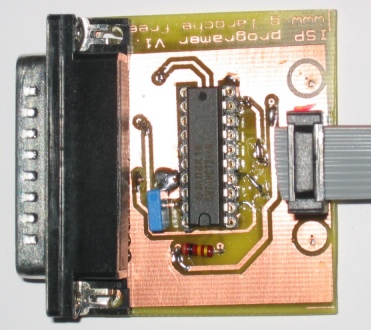 This board can program an AVR microcontroler ATMEL (ATmega8, ATMega32, ...) from a parallel printer LPT1 using ISP functionality In System Programming. This programming type can program and/or configure microcontroler directly on the target board without rmoving device and put it on a separate programmer. This board is compatible with programming software "PonyProg".
Posted on Tuesday, March 30, 2010 • Category: AVR
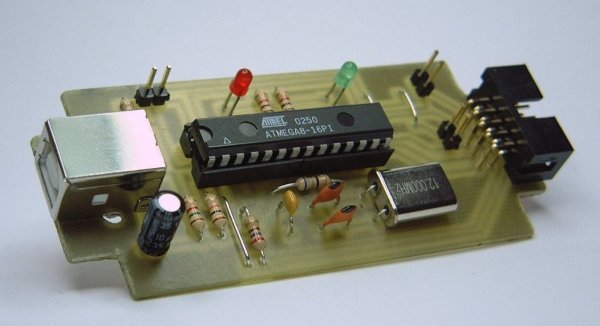 USBasp is a USB in-circuit programmer for Atmel AVR controllers. It simply consists of an ATMega48 or an ATMega8 and a couple of passive components. The programmer uses a firmware-only USB driver, no special USB controller is needed. Works under multiple platforms. Linux, Mac OS X and Windows are tested. * No special controllers or smd components are needed. * Programming speed is up to 5kBytes/sec. * SCK option to support targets with low clock speed (< 1,5MHz). * Planned: serial interface
to target (e.g. for debugging).
Posted on Wednesday, July 8, 2009 • Category: AVR
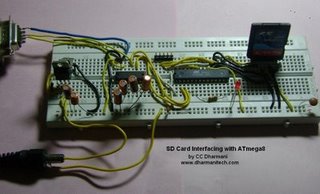 Here is my project on interfacing of SD Card (microSD). MicroSD cards are available very cheap nowadays, a great option for having a huge memory in any embedded system project. It is compatible with SPI bus, so interfacing is easy. SD card adapters are also easily available in market, so one can easily make an bread-board adapter by soldering few pins on it.
In this project, I've used 1GB microSD card from sandisk (later on tested with transcend card also) The microcontroller is AVR ATmega8 running at 8Mhz internal clock. MAX232 is used to interface the circuit with PC for monitoring the data. A 3.3v supply is used for powering the mega8, microSD and max232.
Posted on Thursday, April 24, 2008 • Category: AVR
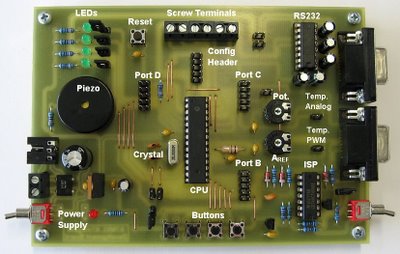 This is versatile development board for AVR microcontrollers ATmega48/88/168. It is good for testing and debugging embedded programs. It has many built-in peripheries connected to microcontroller so you can use them without soldering. ATmega microcontrollers are produced by ATMEL and they include a lot of features: I/O, Timers, PWM generators, ADC, RS232, TWI, SPI, Analog Comparator, Oscillator, EEPROM… These microcontrollers are very versatile, easy to program and easy to use. This is the reason why I like these microcontrollers and why I decided to make development board for them.
Posted on Tuesday, April 22, 2008 • Category: AVR
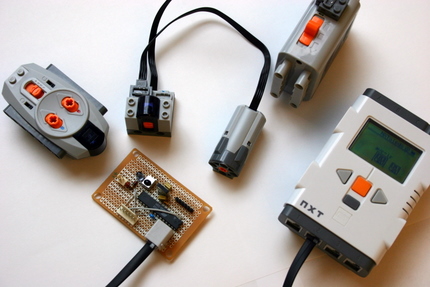 In this project I created an infrared (IR) link that provides bi-directional communication between the NXT and the new Power-Functions system, which consists of a battery box, motors, a remote control (an IR transmitter) and an IR receiver that controls the motors.
I previously built an IR transmitter for the NXT which used an MSP430 microcontroller and which was able to send Sony IR commands (the specifications of this protocol are widely available).
Posted on Friday, April 11, 2008 • Category: AVR
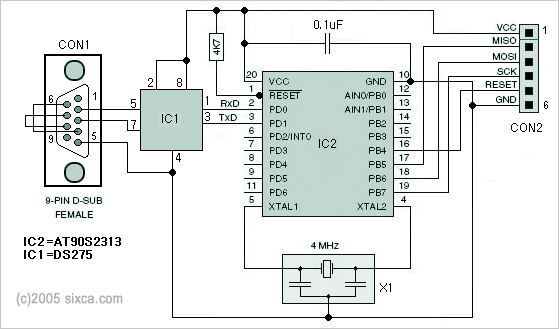 This AVR ISP original by ATMEL you can found on "AVR software and technical Library - April 2003" CD-rom.It small component count I design new PCB and change some component that easy to build small PCB .The new firmware was writen by John Samperi for AT90S2313. This code can program more devices.
Posted on Tuesday, April 8, 2008 • Category: AVR
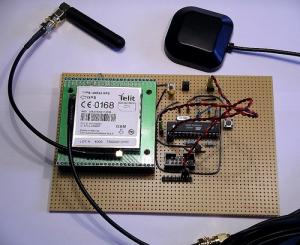 My goal is to build a kind of a mobile tracker. There are many different use cases you can think of but one of the obvious is a device, that is able to report where it is. This device can be put in your car and it could trigger an alarm, if the car got stolen. Actually it could tell you where it is.
There are already mobile tracking devices out there, but they seemed to be too expensive and too closed for my needs. Another option is one of these new Nokia N95 which have built-in GPS. They are really nice, but about 600€, which is not a bargain. So I decided to do my own.
Posted on Saturday, April 5, 2008 • Category: AVR
This simple AVR Programmer will allow you to painlessly transfer hex programs to most ATMEL AVR microcontrollers without sacrificing your budget and time. It is more reliable than most other simple AVR programmers available out there and can be built in very short amount of time.
AVR programmer consists of in-circuit serial programmer (dongle) and small pcb with a DIP socket where you can fit your microcontroller and have it quickly programmed.
You may also use this programmer as a stand alone in-circuit serial programmer that can be used to conveniently program AVR microcontrollers without removing them from the target circuit.
Circuit-Zone.com © 2007-2026. All Rights Reserved.
|
|
|